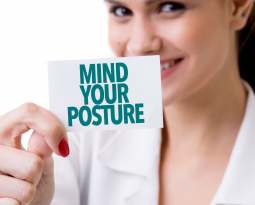
Posture Therapy: Why You are the Solution to a Serious Health Crisis
There are serious consequences of poor posture, and patients are suffering more now than ever before. Poor posture can be associated with musculoskeletal disorders and physiologic dysfunction of the body. These problems are not only causing pain, but they are a burden to the patient and to society.
Did You Know?
- 80% of Americans report having back pain at some point in their lives[1]
- Up to 54% of workers in the western world experience neck pain[2]
- Americans spend between $50-$100 billion per year on back pain[3]
The Global Burden of Disease Study (GBD) is the most comprehensive worldwide observational epidemiological study to date. It describes mortality and morbidity from major diseases, injuries and risk factors to health at global, national and regional levels. The GBD study identified that low back pain is the single leading cause of disability worldwide. Back pain is one of the most common reasons for missed work. In fact, back pain is the second most common reason for visits to the doctor’s office, outnumbered only by upper-respiratory infections.[4]
Occupational Stress Associated with Neck and Back Pain
Patients report neck and back pain associated with their occupational activities. The culprit of many patients’ pain is sitting for prolonged periods of time in awkward postures in front of a computer monitor.
A study published in the European Journal of Public Health concluded that frequent computer-related activities are an independent risk factor for neck and shoulder pain and low back pain. The study reported that daily use of computers for 2-3 hours was the threshold for neck and shoulder pain and daily use of 5 hours was the threshold of low back pain. Due to the demand of computer use in modern occupations, this is a correlating trend of increased complaints of neck and shoulder pain and low back pain from the 1990s to the 2000s.[1]

The reality is that your patients experience pain after using a computer for just 2-5 hours. And yet, many modern occupations require being seated in front of a computer for up to 8 hours per day.
When patients are not on their computers at work, they are commonly on their personal devices. People spend on average 2-4 hours per day on their cell phone with their heads tilted in forward head posture outside of work-related activities.[2] Tilting the head forward in forward head posture has a significant impact on the cervical spine.
Tech Neck Causes Cervical Stress
“Tech Neck” is the term used to describe forward head posture while looking down at your cell phone. Forward head posture is when the ears are in front of the shoulders and the cervical spine loses a neutral position.
A report in the Neuro and Spine Surgery Journal reports that an adult head weighs 10 to 12 pounds in the neutral position. When the head tilts forward in forward head posture while looking at the cell phone the weight on the neck surges to 27 pounds at 15 degrees, 40 pounds at 30 degrees, 49 pounds at 45 degrees and 60 pounds at 60 degrees.[3]
With the increased demand of technology in the digital age, patients are suffering now more than ever before. Technology is not going away, and we don’t want it to. However, at what cost does it come to the patient’s health and well being?
Modern Day Patients Need Modern Solutions
This is the best time in history to become a Posture Expert. Wit the increased occupational demands of sitting in front of a computer screen, and the increased desire to be connected on social media, patients’ posture is suffering.
Posture Therapy is an emerging opportunity. In fact, the millennial generation, which is now entering the workforce, is putting comfort and engagement as top priorities for job satisfaction. According to the Harvard Business Review, 21% of Millennial workers had left their job in the last year to do something else because they were uncomfortable in their workplace, a number that is more than three times higher than that of non-millennial generations.[1]

Corporate America is falling short in terms of engagement, disrupting the potential for High Occupational Performance. According to Gallup poll in 2014, 71% of millennial employees are either not engaged or actively disengaged at work, making them the least engaged generation in the United States.
Modern day workers have modern standards, and modern demands. The literature suggests that sitting in front of a computer is related to neck, shoulder, and back pain, and that looking down at a cell phone significantly increases stress to the cervical spine. In a world where people work 8 hours per day in poor posture in front of a computer, and spend an additional 2-4 hours on their smartphones, there is an emerging need for Posture Experts.
You Are the Solution to a Serious Health Crisis
Being the expert that can effectively identify and reverse postural distortion patterns that may otherwise lead to neck, shoulder, and back pain and poor work performance will differentiate you in the marketplace. Being a Posture Expert in the digital age is a blue ocean market opportunity for success.
Patients need you now more than ever before.
Corporations are in desperate need of your services.
You have never been handed a golden opportunity like this in history. The question is, will you raise your knowledge to expert level in Posture Therapy to take care of modern day patients. Or will you let someone else in your community claim that market gap?

Technology is not going away. If you continue to advance your treatment protocols to take care of modern workers who are engaged with technology on and off the job, then you will have a plethora of new patients.
Complete Postural Correction
To help your patients achieve complete postural correction, the 3-Component Postural Correction system is recommended, including:
- Spinal Alignment Treatment to align the spine and reverse postural distortion patterns.
- Posture Rehabilitation to improve alignment, balance and core control. Posture rehabilitation helps your patients develop postural fitness to overcome common causes of postural collapse.
- Posture Habit Re-Education to improve habits that may otherwise result in poor posture such as tech posture, proper posture while sitting, and ergonomic solutions in the digital age.
You are the solution to a significant health crisis that will only continue to get worse with time. This is the best time in history to become a Posture Expert. This is the blue ocean market opportunity that will take your practice to the next level.













